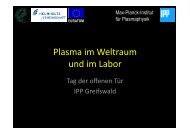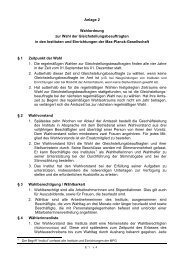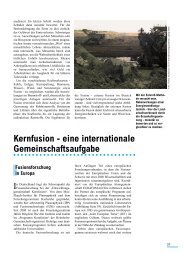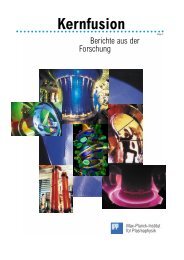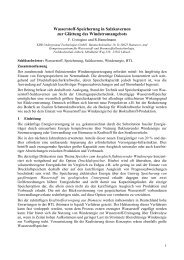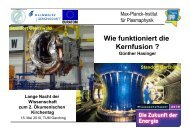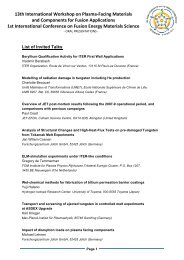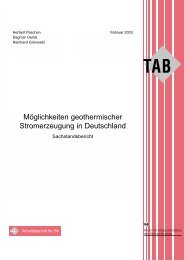IPP Annual Report 2007 - Max-Planck-Institut für Plasmaphysik ...
IPP Annual Report 2007 - Max-Planck-Institut für Plasmaphysik ...
IPP Annual Report 2007 - Max-Planck-Institut für Plasmaphysik ...
Create successful ePaper yourself
Turn your PDF publications into a flip-book with our unique Google optimized e-Paper software.
4.1.1.2.4 Central support elements (CSE)<br />
Each coil is suspended on the central support structure via<br />
two bolted connections between blocks as part of the coil<br />
housings, and extensions of the central support structure.<br />
These connections are typically made of a thick single or a<br />
matrix of up to nine long and elastic Inconel 718 rods to<br />
obtain a preload of 650-900 MP a per bolt at 4 K. Stainless<br />
steel wedges are inserted between the coil blocks and the<br />
shoulders of the CSS extension flanges. The wedges, according<br />
to a new design, are welded onto the coil blocks by<br />
two weld seams each (instead of previously one). The detail<br />
analysis continued in close cooperation with Warsaw<br />
University of Technology. Extended models were completed<br />
for the complex triple and double connections NPC2-Z2 +<br />
NPC3-Z2 + NPC4-Z2 and NPC1-Z1 + PLCA-Z1, respectively,<br />
the new weld design for the wedges was confirmed,<br />
and wedge installation procedures were defined with developed<br />
parametric model of typical CSE. The process of<br />
creation parametric models for all critical CSEs is on-going.<br />
The set of such models allows to analyse variation of parameters<br />
(e.g. tolerances) of components like wedges or shims<br />
during assembly.<br />
4.1.1.2.5 Lateral support elements (LSE)<br />
The lateral support elements are located on the low field<br />
outboard side and transmit tensile, compressive and shear<br />
forces up to 1.7 MN, and bending moments up to 200 kNm,<br />
resp. For the non-planar coil pairs 1-1, 1-2, 2-3, 3-4, 4-5 the<br />
limited space permits welded solutions only. For the LSE<br />
between the coils 5-5 at the module boundary a bolted solution<br />
was adopted. The lateral support element weld dimensions<br />
were finally defined, and the basic design of the bolted<br />
LSE 5-5 at the module interface was completed. The functional<br />
specifications were issued. During assembly quick<br />
assessments concerning cracks and material imperfections<br />
were performed which led to continuation of assembly without<br />
significant interruption.<br />
4.1.1.2.6 Narrow support elements (NSE)<br />
The narrow support elements are sliding contacts (~30 per<br />
half module), located on the high field inboard coil side.<br />
They transmit forces up to 1.5 MN between adjacent coils<br />
while simultaneously allowing relative coil movement up to<br />
5 mm when in contact, and relative coil tilting up to<br />
1 degree. In many cases there is a small initial gap in the<br />
range from 0.2 mm up to 4.5 mm between the sliding surfaces<br />
which close gradually during the coil current ramp-up.<br />
The optimization and definition of the NSE gap widths was<br />
an ongoing issue where the analysis results had to be ready<br />
in correspondence to the assembly schedule. On the other<br />
hand, fixing of these sensitive distances was delayed as long<br />
as possible in order to have the most recent FE model and<br />
design updates available. By end of the year this tedious<br />
Wendelstein 7-X<br />
41<br />
work was done and all gaps for the NSEs inside of the halfmodules<br />
were defined. The tilting of the NSE surfaces<br />
against each other during loading adds a considerable sliding-rolling<br />
path length to the pure relative translational coil<br />
shift. Therefore, pre-tilting in opposite direction was introduced<br />
for the NSEs with large tilting angles. The corresponding<br />
algorithm was developed and implemented in the<br />
design and manufacturing procedure.<br />
4.1.1.2.7 Planar support elements (PSE)<br />
The planar supports fix the planar on top of the non-planar<br />
coils. Most of the PSEs are sliding elements with designs<br />
similar to the sliding NSEs, allowing relative coil movements<br />
up to 10 mm when in contact.<br />
Figure 15: Fixed planar coil support elements; stress intensity in MPa<br />
(bolt preload + EM forces in HJ regime)




